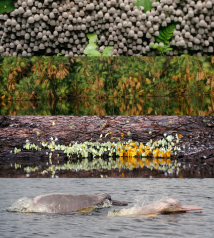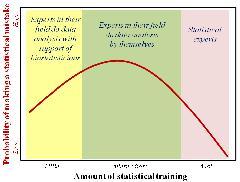
Organism abundance is the parameter most often requiring statistical treatment. Statistics turn our field/lab notes into estimates of population density after considering the individuals we can see and those we can’t. Later, statistical analyses will relate our density estimates to other factors (climate, demography, genetics, human impacts), allowing the examination of key issues such as extinction risk, biomonitoring or ecosystem services (humus formation, photosynthesis, pollination, fishing, etc.). Photos – top: a patch of fungi (Lacandon Jungle, Mexico), next down: a palm forest (Belize river, Belize), next down: an aggregation of butterflies (Amazon, Peru), and bottom: a group of river dolphins (Amazon, Colombia). Photos by Salvador Herrando-Pérez.
Another interesting and provocative post from my (now ex-) PhD student, Dr. Salvador Herrando-Pérez. After reading this post, you might be surprised to know that Salva was one of my more quantitative students, and although he struggled to keep up with the maths at times, he eventually become quite an efficient ecological modeller (see for yourself in his recent publications here and here).
–
When an undergraduate faces the prospect of a postgraduate degree (MSc/PhD), he or she is often presented with an overwhelming contradiction: the host university expects the student to have statistical skills for which he/she might never have received instruction. This void in the educative system forges professionals lacking statistical expertise, skills that are mandatory for cutting-edge research!
Universities could provide the best of their societal services if, instead of operating in isolation, they integrated the different phases of academic training students go through until they enter the professional world. Far from such integration in the last 20 years, universities have become a genuine form of business and therefore operate competitively. Thus, they seek public and private funding by means of student fees (lecturing), as well as publications and projects developed by their staff (research). In this kind of market-driven academia, we need indicators of education quality that quantify the degree by which early-career training methods make researchers useful, innovative and cost-effective for our societies, particularly in the long term.
More than a century ago, the geologist and educator Thomas Chamberlin (1) distinguished acquisitive from creative learning methods. The former are “an attempt to follow by close imitation the processes of other thinkers and to acquire the results of their investigation by memorising”. The latter represent “the endeavour… to discover new truth or to make a new combination of truth or at least to develop by one’s own effort an individualised assemblage of truth… to think for one’s self”. From the onset of their academic training, students of many countries are instructed in acquisitive methods of learning that reward the retention of information, much of which falls into oblivion after being regurgitated during an exam. Apart from being a colossal waste of resources (because it yields near null individual or societal benefits), this vicious machinery is reinforced by reward and punishment in convoluted manners. For instance, one of my primary-school teachers had boys seated in class by a ‘ranking of intelligence’; so one could lose the first seat if the classmate in the second seat answered a question correctly, which the up-to-then ‘most intelligent’ had failed to hit.
There is little science without data analysis

Figure 1: Relationship between statistical expertise and the probability of making a statistical mistake in biological research (modified after 5). Overall, statistical experts might have done an undergraduate/postgraduate course on statistics or enjoyed excellent and sustained supervision by biostatistical mentors/experts/teams. Among the biologists who are experts in their fields (botanics, ecology, zoology, microbiology, etc.), there are those who have received no specialised statistical training (one/few undergraduate subjects), and those who practice statistical self-teaching, often with additional support of short-term, specialised courses. The latter (most biologists!) are the best candidates for making statistical mistakes.
Numerical skills, to measure quantities and their uncertainty, have become the cornerstone of modern science, technological progress and thus, social well-being (2, 3). Further, data analysis is one of the core activities to construct, evidence and communicate new ideas. Regrettably, statistical training is in a precarious state in our field, due to a disconnection between the quantitative nature of ecology and the skills of mentors and students (4). Johnson et al. (5) have eloquently argued that ‘wildlifers’ who either lack or master statistical knowledge always walk on safe ground, because the former rely on experts to do their analyses, whilst experts can of course work out their numerical riddles by themselves (Figure 1). In contrast, the majority of scholars, across all levels of expertise, dwells in a statistical limbo prone to ill application, inference and/or reporting.
The kind of statistics that universities should teach, to tackle the research areas modern biologists deal with, are clear (6-9): (i) forecasting future scenarios (e.g., how much will global temperatures increase by the end of this century?), (ii) working at different spatial and temporal scales (e.g., how much microscopic soil fungi fuel the dynamics of an entire forest?), and (iii) measuring relationships between variables that are nonlinear (e.g., fertility rates of a tuna shoal might decrease faster at high than low numbers) and might result in different outcomes (e.g., at low densities, a population of butterflies might go extinct whether it rains or not). However, in the biological sciences, and in their application for conservation and management, teaching methods encouraging any acquisitive-learning behavior will be inappropriate for statistics. I think it is self-evident that statistics are a dry and feared subject for most biologists, and necessitate exceptional teaching methods (certainly not acquisitive ones) (Box 1). The biologist’s aversion to statistics is of such magnitude that we mostly fail to realize the practicality that our professional income will be proportional to our statistical proficiency (10).
Box 1: Five suggestions for statistical teaching
- Humour and imagination are a must in statistical teaching – motivated lecturers use jokes, tales, poems, videos, magic or even rap music (11).
- Students are likely to understand key themes (like calculus or probability) through card and lottery games. However, they will identify themselves with statistics if they can use real data with direct environmental/social application.
- Undergraduate programs in the biological sciences should present classic statistics (analysis of variance, linear regression, null hypothesis testing) and modern statistics (likelihood, bootstrapping, multi-model inference, generalised linear modeling, Bayesian inference) in a comparative, balanced fashion (12). If one subject can’t include all in a single degree, we need more statistical subjects per degree and more biologists who can teach them.
- Programming is nowadays an important skill to tailor a given data analysis to a particular research question (13), because commercial packages are laden with options by default an investigator has no control (even awareness) of.
- Statistics are a set of tools, and students should see them as one of a sequence of steps of an investigation (14, 15) – for any research, we reach at the statistical stage after formulating testable hypotheses and collecting good data, and we use statistical tests to communicate science to other scientists, managers, politicians and society as a whole (3).
Having recently moved from Australia back to Spain (after completing my PhD degree at The University of Adelaide), I am faced with a national reality; that is, if governments – in collaboration with academic institutions – do not regard science as a profitable investment in the long term, then scientific instruction (of statistics and other majors) will tend to mediocrity. This sort of government can be easily recognised because it moves ‘the sciences’ – and the environment – from one cabinet to another, from one ruling period to the next, as though it was unclear from what stance they should be managed. For many decades in these research-developing countries, and whether or not there is economic crisis or boom, many professionals have been forced to migrate to other countries with a modern and updated scientific culture.
Salvador Herrando-Pérez
–
Author’s note: this article is based on the Foreword of my PhD thesis: S. Herrando-Pérez (July 2012). Resolving conceptual confusion and quantifying cross-taxa pattern of ‘density dependence’ in population ecology. The University of Adelaide, Australia.
References
- Chamberlin, T. C. (1890) Science 15, 92-96
- Davidian, M. & Louis, T. A. (2012) Science 336, 12-12
- Kroll, A. J. (2007) Journal of Wildlife Management 71, 226-230
- Ellison, A. M. & Dennis, B. (2010) Frontiers in Ecology and the Environment 8, 362-370
- Johnson, D. H., et al. (2001) Wildlife Society Bulletin 29, 1055-1060
- Clark, J. S., et al. (2001) Science 293, 657-660
- Green, J. L., et al. (2005) Bioscience 55, 501-510
- Hastings, A., et al. (2005) Bioscience 55, 511-517
- White, G. C. (2001) Wildlife Society Bulletin 29, 380-386
- Cipra, B. A. (1989) Science 243, 314
- Lesser, L. M. & Pearl, D. K. (2008) Journal of Statistics Education 16, [Available at www.amstat.org/publications/jse/v16n13/lesser.pdf]
- Butcher, J. A., et al. (2007) Journal of Wildlife Management 71, 2142-2144
- Lang, D. T. & Ihaka, R. (2008) Technometrics 50, 443-446
- Boyles, J. G., et al. (2008) Journal of Wildlife Management 72, 1869-1871
- Zuckerberg, B. & Gibbs, J. P. (2008) Frontiers in Ecology and the Environment 6, 505-506
-34.917731 138.603034

